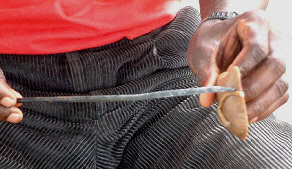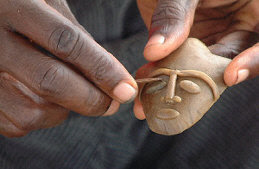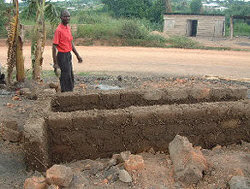The "lost wax" brass process is an ancient tecnique used for making brass models and sculptures. Amongst the Asante of Ghana this technique was used to mend the bones of ancestors which are considered sacred. It was also used to make the gold ornaments so beloved in West Africa. Nowadays brass is more commonly used... First a detailed model object is made completey out of bees wax. This wax mould is then hardened with ash and prepared for the kiln where recycled brass is melted and replaces the wax - which is "lost". See how it's done below.
Making the wax model
Wax from the African honey bee is used
First it's formed into the rough shape and size needed
Sometimes the wax is pressed into moulds to form the basic shape
After the basic shape has been formed...
Pieces of wax are modelled to make the decorations
Then the decoration can begin
An old syringe is used to make strings of wax
But when you need a lot production can be cranked up using innovative technology!
This is fiddly work - the fine strings of wax are shaped and fused to the base shape - it needs a steady hand and great concentration...
After the strings of wax have been applied they are sculpted - every detail made in wax will be replaced by brass
The finished wax faces - Adinkra symbol "gye nyame" moulds
Beads and hollow brass models are made from fine strings of wax built up over a charcoal mould
All done with these simple tools...
And all part of a day's work for this artisan at his workbench
Building up the wax model into a mould
Pieces of charcoal are pounded...
Into a fine powder
The powder charcoal is mixed with water...
And the wax models are dipped into the mixture
And given a thick coating...
And then left to dry and harden
Channels are left for the brass to pour in and replace the wax
Preparing the moulds for the kiln
The models are dipped again and again to build up the mould cases
As the moulds build up fibrous material is added to the mixture to strengthen it
The Kiln
Crucibles are made that exactly fit over the finished the finished moulds
How it works is that you put the brass in here...
And it fits on top like this
Brass taps and pipes are often used
Along with brass models that didn't work out
The crucibles are all filled with brass and then joined together to the waiting mould
A trench kiln is prepared and the crucibles are put in the kiln and fired. As they get hot the wax melts and the molten brass flows in and takes its place
Cleaning and finishing
After they have baked in the kiln the crucibles are broken open to reveal the finished pieces inside
But it's not over yet... each of the pieces has to be cleaned which is a long job
Everyone in the workshop helps out - even the children
In fact it's a family job... and this is how children start to learn the skill
This man is working on an X rated model.... something for everyone!
And here are the glorious finished pieces - all cleaned and shiny
People come from all over the world to see the skills of these artisans...
And we say good by to the artisans at the "lost wax" brass workshop in Ghana
Thursday, December 1, 2011
Subscribe to:
Post Comments (Atom)























































No comments:
Post a Comment